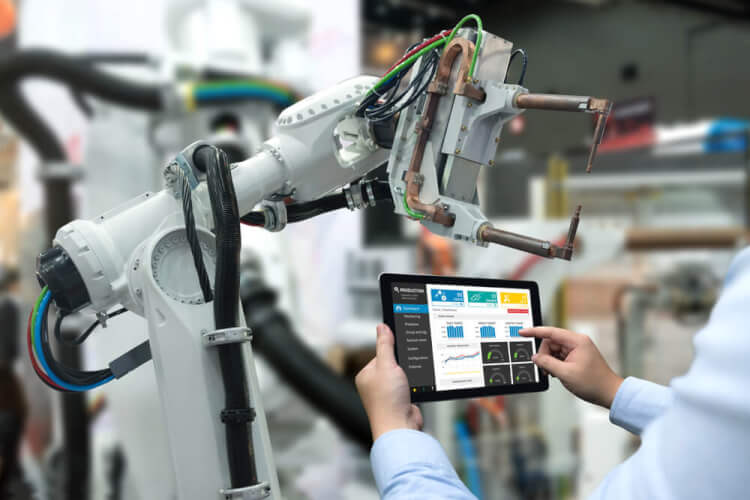Transformation using advanced digital technology is occurring in all industries. Manufacturers of manufacturing equipment are no exception. Manufacturing equipment manufacturers, which have been in a highly competitive market for some time, are faced with a series of sudden and unpredictable situations such as the new entry of digital native startups equipped with advanced technology and the new coronavirus, and the agility to respond to such events. and flexibility, and resilience are required. To that end, what is now required of manufacturing equipment manufacturers is transformation through “digital transformation.”
In this article, we will introduce the IoT utilization that many manufacturing equipment manufacturers have started working on as part of their digital transformation.

INDEX
- Real-time monitoring of manufacturing equipment by remote monitoring
- Risks of Not Embracing Digital Transformation
- PTC ThingWorx Powers Industrial IoT
Real-time monitoring of manufacturing equipment by remote monitoring
“Remote monitoring” is attracting attention as a digital transformation initiative that has high expectations for increased profits for manufacturing equipment manufacturers. By connecting IoT to your own equipment, you will be able to check the status and operating status of your equipment from anywhere.
Many of today’s manufacturers of manufacturing equipment follow a so-called “reactive response” approach, in which customers contact customers when problems arise in post-sales maintenance work. If equipment malfunctions or breaks, we immediately rush to the site, investigate the cause, and work to correct it. It is said that this scene, which was commonplace in the past, will decrease in the future due to the implementation of remote monitoring.
Manufacturers of manufacturing equipment that have introduced remote monitoring use IoT to constantly grasp the condition and operating status of equipment, and do not overlook signs of malfunction or failure by setting their own thresholds. Therefore, if it is predicted that a malfunction or failure will occur in the equipment, we can go to the site and make corrections to minimize the non-operating time of the equipment.
In addition, through remote monitoring, we can not only predict malfunctions and failures, but also check information in advance about why malfunctions and failures are likely to occur. Or you can improve the diagnostic accuracy at the first visit
Risks of Not Embracing Digital Transformation
Are you familiar with the term “digital disruption”? This is a phenomenon in which new entrants equipped with advanced digital technology overturn the conventional business model in the market and dominate the market under new rules. In the past, Amazon’s e-commerce business, Apple, which swept the music media market, and Airbnb, which greatly changed the real estate industry, are cited as representative examples of digital disruption.
Manufacturing equipment manufacturers are said to be lagging behind other industries in the development of digital technology. Capgemini predicts that 50% of products on the market will be connected and made smart by IoT. Other well-known research firms have made similar predictions. In other words, the digital transformation utilizing IoT is steadily progressing even among manufacturing equipment manufacturers.
So what are the risks for manufacturing equipment manufacturers who do not engage in digital transformation? In the world of digital technology, there is a principle that the first movers who actively implement new initiatives have an advantage. Their knowledge of the initiative itself and the quantity and quality of data obtained from equipment connected by IoT are overwhelmingly different from companies that do not engage in digital transformation. This difference directly acts as market competitiveness.
Companies that are left behind by changes will lose their relative market competitiveness, and their sales and profits will be adversely affected by the decline in efficiency and cost efficiency of the value chain , including services.
Digital transformation is not “renovation of old core systems”. Renovation of legacy systems is to prepare for digital transformation, and it is important to consider renovating the business model itself in addition to improving business efficiency.
PTC ThingWorx Powers Industrial IoT
New solutions are needed for the digital transformation of manufacturing equipment manufacturers, namely remote monitoring through the industrial IoT. Here, we will introduce the industrial IoT platform “ThingWorx” provided by PTC.
ThingWorx is a platform that provides essential functions for realizing industrial IoT, such as connecting various devices, building applications, data analysis, system management, and worker support through user experience.
Of particular note is the productivity of IoT application development. When working on industrial IoT, there are many cases where specific specifications cannot be fixed even after interviewing the workers and managers who actually use it. In addition, IoT applications that have been built once are often required to be modified many times during the operation stage, which tends to reduce development productivity.
ThingWorx, on the other hand, is equipped with a mechanism that increases development productivity by providing IoT application construction and system operation on a web browser. Developers can quickly develop graphical and intuitive IoT applications and customize their designs. It is also possible to custom add widget parts, and it is easy to modify the IoT application once built.
In addition, ThingWorx can be operated not only in cloud environments but also in on-premise environments, and has the flexibility to support a hybrid environment that combines the two. In recent years, configurations such as accessing the Internet from a gateway device installed in the facility and then managing it with ThingWorx operating in a cloud environment are gaining popularity.
Coordination with other systems is important for industrial IoT, and inevitably the industrial IoT platform is required to have connectivity with the system. ThingWorx can be linked with existing in-house systems and systems made by other companies, and as a strategic partner of Microsoft, Microsoft Dynamics 365 connect to
Digital transformation by manufacturing equipment manufacturers will continue to accelerate. Companies that fail to respond to industrial IoT will gradually lose their competitiveness. Please take this opportunity to consider introducing industrial IoT in your own products.


